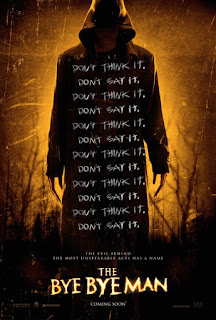Meddling Kids Go Adios: "The Bye Bye Man" inanely executes cool premise
The Bye Bye Man (2017)
96 min., rated PG-13.
“The Bye Bye Man” contains the tiniest kernel of a cool, creepily folkloric idea—an entity has the power to force a person to see things that aren’t there, not see things that are there and commit generally horrible acts when its name is spoken or given any thought—that could have resulted in a 21st century cross between “A Nightmare on Elm Street” and “Candyman.” To be fair, there have been far worse hooks for January-released PG-13 horror movies, but even by those standards, this one is still clunky, perfunctory and inanely executed. Centering their titular boogeyman as a flimsy plot device that would scare as an urban legend around a campfire, director Stacy Title (1995’s blackly comic, ahead-of-its-time indie “The Last Supper”) and screenwriter Jonathan Penner (the director’s husband and a three-time contestant on TV’s “Survivor”) seem to have learned all the basics to make a horror movie but don’t have the stylistic chops to actually make an effective one on their own.
Looking to get out of the dorms of a Wisconsin university, slightly dorky college student Elliot (Douglas Smith) and pretty girlfriend Sasha (Cressida Bonas), along with Elliot’s jock best friend John (Lucien Laviscount), rent out a furnished old house off campus. Sasha is the first to feel a supernatural presence, and then a silver dollar coin keeps falling out of an old nightstand with the inside of the drawer reading, “Don’t think it, don’t say it,” ad nauseam. Elliot ruffles through the drawer, only to find the name, “The Bye Bye Man,” carved underneath the liner. After a house party in their new digs, Sasha’s psychically sensitive friend Kim (Jenna Kanell) holds a seance with the three housemates that only ends up inviting the hooded reaper (Doug Jones) going by the name “The Bye Bye Man." Elliot begins to research a mass murder that took place in town nearly 50 years ago and could be linked somehow, but these four friends are already driven to insanity by just speaking and even thinking the man’s name. They all grow paranoid—Elliot thinks Sasha is sleeping with John when she’s not, and Sasha keeps seeing John come on to her—and lose track of time, while one of them comes down with a fever and a case of the sniffles. As the Bye Bye Man edges closer and closer to them, they might as well kiss their own asses goodbye.
Based on short story “The Bridge to Body Island” by Robert Damon Schneck, “The Bye Bye Man” is creepier on paper than in the delivery where it actually counts. Moments of unease and impending doom are temporary, and the husband-and-wife filmmakers fumble their rules so badly that the longer one gets away from this silly mess, the more they want to tear it apart. 2015’s “It Follows,” also about a stalking entity that spreads from person to person, was able to get away with little exposition because its rules were set and the sense of dread was inescapable, but here, no one has seemed to figure out the hows and whys. First off, the mythology of the Bye Bye Man is actually nonexistent and left unexplored, despite our hero taking an obligatory trip to the library archives. Was he ever an actual person, like Candyman and Freddy Krueger, or has he always been a nightmarish manifestation of people’s minds? No idea; he just is. And why the silver dollar coins? Also, what the hell is with the Bye Bye Man’s man-eating bloodhound at his side? It certainly doesn’t help that the horrendously animated canine looks more like the weed-smoking Freddy Krueger caterpillar from 2003’s “Freddy vs. Jason” and poses little menace. Secondly, the characters give the ghoul power by saying/thinking his name, but they will slowly die off after having their minds messed with. So, if his name is never spoken or given a moment’s thought, what does the BBM do on his off days? In spite of being under major duress, the characters soon act illogically and none too brightly. If one of them says with a lucid enough mind that He Who Must Not Be Named can play tricks on them, how is it that he or she immediately gives in when spotting a bloodied family outside of their wrecked vehicle next to the train tracks? The subsequent death plays out so quickly without any suspense that it almost seems like it could register as a hallucination for the audience.
Character factoids are introduced and then abandoned, like Elliot’s parents dying in a crash, possibly involving a train since there is so much baffling locomotive imagery, but who’s to know? The characters aren’t unlikable or uncharismatic, but they sure are thinly characterized and the actors never quite convince once they have to project fear. A lot of what comes out of their mouths is insultingly on-the-nose and, thus, provokes accidental laughs. This goes with someone trying to get their mind off of the Bye Bye Man while driving by singing along with The Everly Brothers to their 1958 ditty “Bye Bye Love.” Douglas Smith goes for it as Elliot (and on occasion morphs into Rami Malek), while Cressida Bonas is so flat and bland as Sasha that she can’t even sneeze convincingly. Aside from the spindly Doug Jones who works better in the shadows as the Bye Bye Man, the one thespian to make the most impression is Jenna Kanell, who has little screen time as goth psychic Kim. Two other roles are thanklessly filled by tested actresses deserving of more to do. Carrie-Anne Moss, who must be paying off a debt, unbelievably acts with a straight face as a detective who hangs up her initial skepticism about Elliot babbling on about an evil force. And then, in case one was wondering what Faye Dunaway was up to, here she is, appearing for less than a day’s work to shovel out exposition as Widow Redmon and hand a co-star a revolver as a solution to his problems. Dunaway looks regretful, but we can't blame her.
One can actually see this concept playing well with a smarter script that didn't under-think everything and more confident direction, but as it stands, there aren’t many nice things to say about “The Bye Bye Man.” Appreciably, the film does not rely constantly on easy, screechy jolts. Then again, it’s so apparent where it was cut down from an R-rating. Take the virtually bloodless prologue, set in 1969, where the Bye Bye Man’s first victim (a town reporter played by Leigh Whannell) blows away his suburban neighbors on a sunny day with a shotgun, which apparently is filled with blanks. Belying its otherwise watered-down PG-13 rating, the conclusion is at least grimly uncompromising and should feel like a punch to the gut, but the film hardly earns it. “Don’t think it, don’t say it,” the characters repeatedly say as a warning to themselves and others, but let’s just call it a day and say what everyone is so predictably thinking: don’t see it. Hey, the film was asking for it.
Grade: D












Comments
Post a Comment